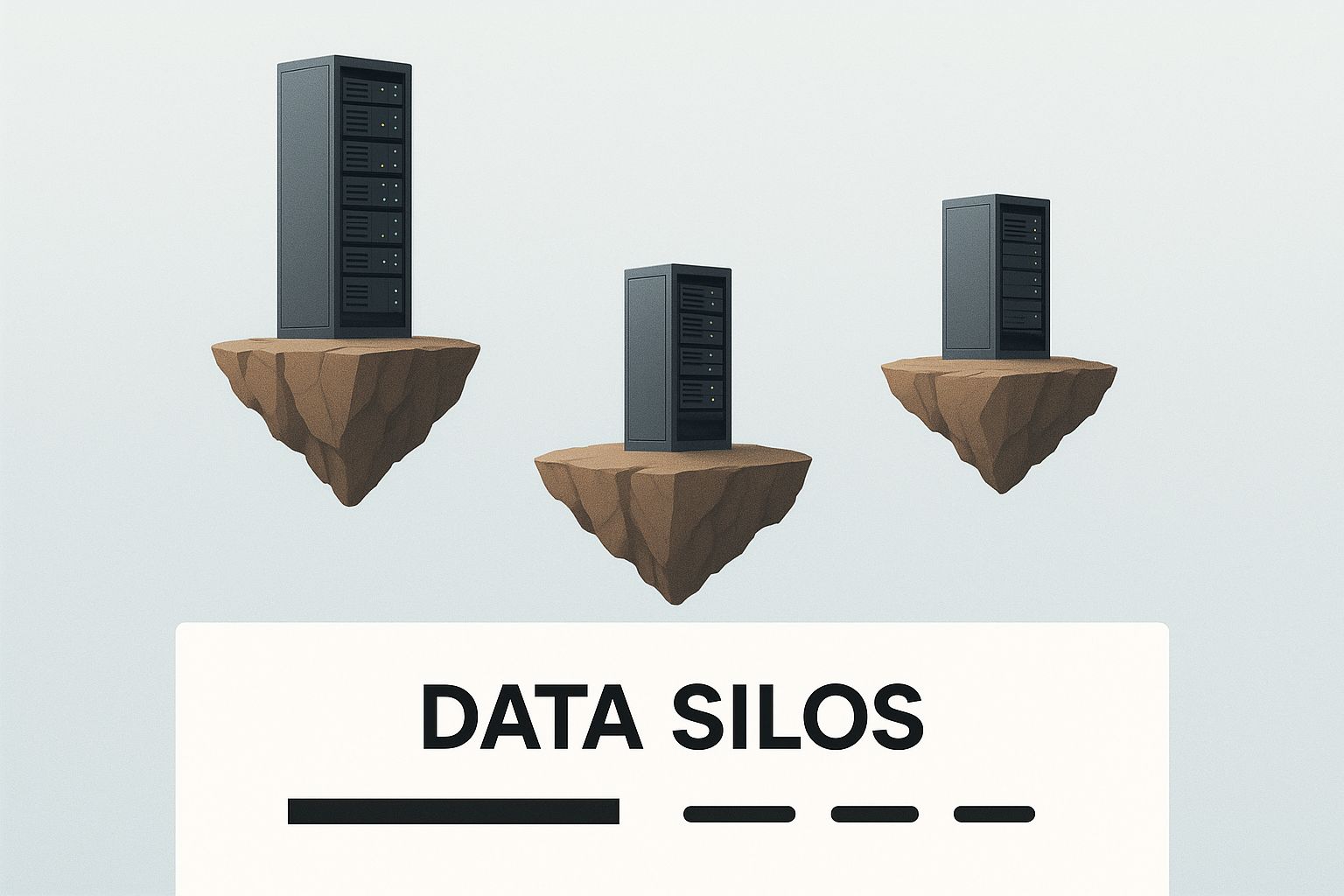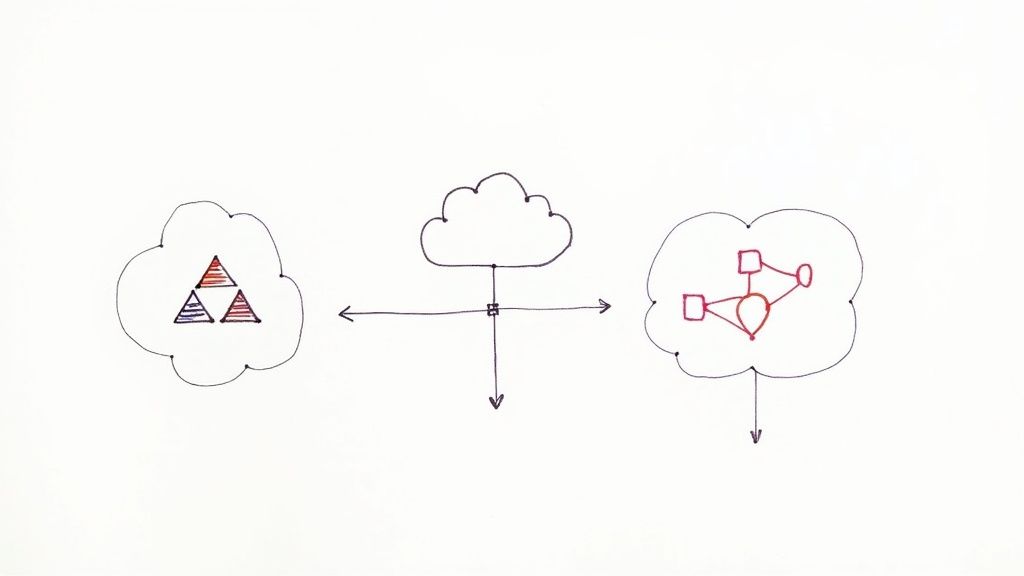Solving Your Data Integration Issues
Tackle the most common data integration issues with our expert guide. We break down complex challenges and provide practical, real-world solutions that work.
When you hear about data integration issues, it’s easy to think of them as just another IT problem. But in reality, they're the roadblocks—both technical and organizational—that stop data from moving smoothly between your different systems.
These aren't just minor glitches. They can be anything from simple typos in a customer record to massive incompatibilities between mission-critical software. Left unchecked, they lead to analytics you can't trust, resources down the drain, and business decisions that are based on guesswork.
The True Cost of Disconnected Data

Think of it like trying to run a business where every department speaks a different language. Marketing is tracking leads in its own system, sales is managing deals in another, and finance is tallying revenue in a third. That's the daily reality of disconnected data—a constant source of friction, confusion, and missed opportunities.
These integration headaches are much more than a technical annoyance; they're a direct hit to your bottom line. When data gets trapped in isolated silos, the fallout spreads across the entire company.
Flawed Decisions and Wasted Hours
The most immediate and painful impact is on decision-making. Without a single, unified view of what's going on, leaders are flying blind, making critical calls based on incomplete or contradictory information. This is how you end up with misallocated budgets, ineffective strategies, and a culture of reacting to problems instead of anticipating them.
It's a huge productivity killer, too. Some estimates suggest that IT teams can spend up to 30% of their time just on data prep that ultimately goes nowhere.
On the ground, fragmented data creates frustrating workarounds for your teams. People are stuck exporting spreadsheets and manually cross-referencing records just to get a coherent picture. This isn't just a morale killer; it pulls your best people away from the strategic work they were hired to do.
"When teams can’t access unified data, they waste an average of 12 hours per week searching for information, a productivity drain that can cost companies millions annually."
The Foundation for Modern Success
At the end of the day, solving these integration challenges is non-negotiable for any modern business. A seamless flow of information is the foundation for everything from reliable business intelligence to the most advanced AI applications.
If you want to get ahead with innovations like AI, you first have to get your data house in order. That means making sure your information is accessible, accurate, and ready when you need it. To see how this plays out in practice, you can dive deeper in our guide to real-time data analytics.
Why Most Data Integration Efforts Falter
Ever wonder why so many data integration projects seem to hit a wall? The root cause is usually something surprisingly simple, yet incredibly tough to fix: data silos.
Picture each department, app, or system in your company as its own little island. The sales team has its island of CRM data, marketing has its analytics island, and finance has its ERP island. They're all collecting valuable information, but it's completely cut off from everyone else. This isn't some rare problem; it's the default state for most businesses.
The average organization is juggling nearly 900 different applications, but a shocking 29% of them actually talk to each other. This leaves you with a massively fragmented view of your own business, where critical information is trapped just out of reach of the people who need it most.

As this image shows, these disconnected systems make it impossible to get a unified view, creating friction that slows down the entire company.
The Real-World Impact of Information Islands
When your data is stuck on separate islands, the fallout isn't just a technical headache—it creates real roadblocks to growth and efficiency that ripple across the entire organization.
The business impact of data silos is significant and widespread, affecting everything from marketing effectiveness to customer satisfaction. The table below breaks down how these information islands can undermine key business functions.
The Business Impact of Data Silos
Business AreaPrimary ConsequenceReal-World ExampleMarketingIneffective Campaign SpendThe team runs a huge campaign based on web traffic, not knowing that the leads generated have a near-zero conversion rate according to the sales CRM.SalesMissed OpportunitiesA sales rep is unaware that a lead has multiple open support tickets, and they attempt an upsell, resulting in a poor customer experience.Customer SupportFrustrated CustomersAn agent can't see a customer's full order history and has to ask them to repeat information they've already provided multiple times.Executive LeadershipFlawed Strategic PlanningThe C-suite makes a major budget decision based on incomplete financial data, missing crucial insights from operational systems.
These examples are not just hypotheticals; they happen every day in businesses that haven't connected their data. This lack of a unified view forces teams to make decisions with only a fraction of the information they need.
It's a widespread issue. In fact, 95% of organizations report struggling to integrate data across their systems. Data silos have become the single biggest barrier to automation and AI, a problem cited by 80% of companies. When teams can’t get the data they need, they waste an average of 12 hours per week just searching for information—a productivity killer that can cost a company $7.8 million annually. For more on this, you can review B2B stats on integration challenges.
From Technical Problem to Strategic Imperative
Tearing down these data silos isn't just an IT task; it's a strategic business decision. When data flows freely and securely between systems, it creates a solid foundation for operational excellence and gives you a serious competitive edge.
Fixing these integration problems is the first step toward becoming a truly data-driven organization. It allows teams to work together more effectively and unlocks the door to powerful analytics, automation, and AI. This often means adopting modern data movement strategies, which you can learn more about by exploring the challenges of real-time ETL.
Ultimately, connecting these information islands is how you turn raw data into your company's most valuable asset.
The Cascade Effect of Poor Data Quality

While data silos act like walls, poor data quality is more like a poison that seeps through the cracks and contaminates your entire data ecosystem. It’s one of the sneakiest data integration issues because it rarely starts with a bang. Instead, it begins with a whisper—a single typo, a misplaced decimal, or a duplicated customer record.
But these seemingly tiny errors don't stay small. Much like a single contaminated ingredient can spoil an entire batch of food, one bad data point can set off a disastrous chain reaction. That one incorrect customer entry can lead to botched marketing campaigns, wildly inaccurate sales forecasts, and analytics reports that are just plain wrong.
Before long, trust in the data evaporates, and your teams are back to making decisions based on gut feelings instead of hard evidence.
The financial bleed from bad data is genuinely shocking. Recent research shows that 64% of organizations cite data quality as their biggest data integrity challenge. The hidden costs are even worse, estimated to be anywhere from $9.7 million to $15 million per year in wasted operational spending. Think about that—a huge chunk of that cost is just wasted effort, with IT teams spending an estimated 30% of their time trying to fix data problems.
From Minor Errors to Major Failures
The consequences of poor data quality ripple outward, often causing systemic failures that can completely derail major business projects. When bad data gets into your integration pipelines, it corrupts everything it touches.
These aren't just abstract risks; they have tangible, expensive impacts.
- Corrupted Analytics and BI: If your source data is garbage, your dashboards will be, too. This leads to confident but completely wrong decisions.
- Failed Customer Experiences: Ever received a promotion for a product you just returned? Or been addressed by the wrong name? That’s bad data at work, and it kills brand loyalty.
- Operational Inefficiency: Teams burn countless hours manually cleaning up messy data or creating clumsy workarounds, pulling them away from work that actually matters.
This problem is so widespread that large-scale data projects have an 85% failure rate. Integration efforts specifically fail or partially fail in 84% of cases, with poor data quality being a primary culprit behind these dismal numbers.
Shifting from Cleanup to Proactive Management
Treating data quality as an afterthought—something you’ll "clean up later"—is a strategy doomed to fail. The only way to win is to treat it as a critical business risk that needs to be managed proactively, right at the source. Understanding the full scope of common data integrity problems is the first real step.
This means putting validation rules in place before data gets in, establishing clear data governance policies, and using tools that can spot and flag problems before they ever reach your analytics environment. When you make data quality a priority from the very beginning, you protect the integrity of your entire data pipeline and ensure your integration efforts actually deliver the value they're supposed to.
Your Guide to Common Integration Hurdles
Alright, we’ve seen how disconnected systems and messy data can wreak havoc on a business. Now, let’s get our hands dirty and look at the specific technical roadblocks that cause all that chaos. Think of these as the individual speed bumps and potholes you'll hit on the road to a smooth data flow. Knowing what they are is the first step to building an integration strategy that can actually withstand the real world.
Each of these common data integration issues is a unique puzzle, from mismatched data structures to the relentless need for speed. By breaking them down one by one, we can find the right tools and tactics to stop small technical glitches from snowballing into massive business headaches.
Navigating Schema Mismatches
Imagine you have two different systems that need to talk to each other. One system stores a customer’s full name in a single field, FullName. The other, however, splits it into two fields: FirstName and LastName. This is a classic schema mismatch, and it’s the data equivalent of trying to fit a square peg into a round hole. The data’s structure, or schema, in the source system just doesn't line up with the destination.
This is probably one of the most common issues you'll run into, simply because different applications and databases are almost never built to speak the same language. If you don't have a plan to translate between them, you’re looking at lost data, corrupted information, or integrations that flat-out fail.
The solution is to build a smart transformation layer that acts as a universal translator. This usually involves:
- Data Mapping: This is your Rosetta Stone. You create clear, explicit rules that define how a field in System A corresponds to a field in System B.
- Automated Schema Handling: Modern tools can often detect when the source schema changes—say, a new field is added—and adjust the mapping on the fly. This is huge for preventing your data pipelines from breaking every other week.
- Data Cleansing: You can also clean things up during the translation. For instance, you can standardize all date formats to a single, consistent style (
YYYY-MM-DD) before the data lands in its new home.
Overcoming Performance Bottlenecks
An integration process that works perfectly when you have a few thousand records a day can completely fall apart when that number jumps to a few million. And it will. As your business grows, your data volume explodes. This is a performance bottleneck—the system simply can’t process data fast enough to keep up.
This often happens when you're stuck with old-school batch processing, where data is moved in huge, infrequent chunks. The system gets totally overwhelmed, leading to major delays. By the time the data arrives, it might be too old to be useful for making timely decisions.
The real key here is to shift your thinking. Instead of moving data in massive, slow batches, you want to stream it in a continuous, manageable flow. This approach is much easier on your systems and ensures the data is always fresh.
Meeting the Demand for Real-Time Data
In today's world, waiting 24 hours for a data refresh is a business killer. Companies need information right now to react to customer behavior, manage inventory on the fly, and spot fraud as it happens. The problem is, many traditional integration methods were built for a slower world, creating huge latency—the delay between when something happens and when you can actually see the data about it.
Take an e-commerce platform. It needs to know the instant an item’s inventory level gets low to avoid selling products it doesn't have. If the inventory data only syncs overnight, the business is flying blind for hours, leading to angry customers and operational chaos. Real-time data isn't a luxury anymore; it’s a fundamental requirement.
Managing Security and Compliance Risks
Finally, let's talk about the big one: risk. Every time you move data between systems, you open up a potential security vulnerability. During extraction, transformation, and loading, data is in motion and can be exposed. Without the right safeguards, you could be risking a breach of sensitive customer information or running afoul of regulations like GDPR or CCPA.
A solid data integration strategy has to be built on a foundation of security. That means prioritizing it at every single step:
- Encryption: Your data must be encrypted both in transit (while it’s moving between systems) and at rest (when it's being stored). No exceptions.
- Access Controls: Lock it down. Implement strict, role-based permissions to ensure only authorized people and systems can touch the data.
- Auditing and Monitoring: You need a paper trail. Keep detailed logs of all integration activities to see who accessed what, and when. This makes it infinitely easier to spot a threat and respond quickly.
Modern Strategies for Seamless Integration
If you feel like you're constantly fighting fires with your data integration, you're not alone. The good news is that we're moving past the old ways of doing things. Clunky, manual ETL processes are being replaced by smarter, more automated approaches that are built to handle today's data chaos.
These modern strategies are all about tackling those familiar headaches—bad data, mismatched schemas, and slow performance—head-on. The goal is to build a data architecture that’s not just stable, but can actually grow with your business without constant hand-holding.
The Rise of Automation and Cloud Platforms
One of the biggest shifts has been toward cloud-based tools, specifically Integration Platform as a Service (iPaaS). Think of an iPaaS as a central command center for all your data connections. It handles the messy, complex plumbing for you. These platforms come loaded with pre-built connectors and automated workflows that dramatically cut down the time it takes to connect one system to another. Exploring a specific use case, like mastering ecommerce payment gateway integration, highlights the kinds of persistent challenges these modern platforms are designed to eliminate.
At the same time, no-code and low-code platforms have put data integration into the hands of more people. Business analysts and other non-technical folks can now build and manage data pipelines using simple drag-and-drop tools. This is a huge win, as it frees up your engineering team to work on the truly tough problems instead of getting bogged down in routine pipeline maintenance.
AI-Powered Data Pipeline Management
Artificial intelligence is also stepping in to change the game, especially when it comes to keeping pipelines running and data clean. AI-driven tools can spot anomalies, predict when a pipeline might fail, and even fix certain data quality errors automatically—before they ever poison your analytics. This allows teams to stop reacting to problems and start preventing them.
The global data integration market is projected to grow at a CAGR of 13.8% through 2025, but human error remains a major bottleneck. AI-powered automation is a key solution, capable of cutting pipeline maintenance by 70% and preventing 90% of data quality issues from ever reaching production. Discover more insights about these data integration trends.
By adopting these strategies, you're not just moving data from point A to point B anymore. You’re creating intelligent, automated, and reliable data flows that become the foundation for smarter business decisions.
Have Questions About Data Integration? We've Got Answers
You're not alone if you've got questions about data integration. As you start connecting different systems and trying to get your data to flow smoothly, you're bound to run into a few snags. We’ve pulled together some of the most common questions we hear to help you sidestep those hurdles and make smarter decisions.
Let’s get straight to the point with some clear answers.
What's the Single Most Common Data Integration Problem?
Data silos are a huge architectural headache, for sure. But the problem that trips people up day after day is simply poor data quality. Inconsistent formats, duplicate entries, missing values, and flat-out wrong information—this stuff is like sand in the gears of your entire data operation.
Think of low-quality data as the root of most other evils. It’s what causes schema mismatches to fail and transformation jobs to break. Because its effects are so widespread, making data quality your number one priority is the smartest move you can make.
I like to put it this way: you can build the most sophisticated plumbing system in the world, but if the water you're pumping is dirty, the whole setup is worthless. Clean your data at the source—it’s more critical than anything else you’ll do.
How Can I Get Ahead of Data Integration Problems?
The best defense is a good offense. Instead of constantly fixing broken pipelines (which is exhausting), a proactive strategy will save you time, money, and a whole lot of frustration.
Here are the key tactics to prevent issues before they start:
- Set up a Data Governance Framework: This isn't just bureaucracy. It's about creating clear, simple rules for who owns what data and what "good" actually looks like.
- Do Your Homework First: Before you write a single line of code, map everything out. Understand the source schemas, how the data needs to move, and where the potential conflicts are. A little planning goes a long way.
- Pick the Right Tools for the Job: Don't get stuck with a tool that can't grow with you. Modern, scalable platforms are built to handle the massive data volumes of today without grinding to a halt.
- Automate Your Quality Checks: Build automated checks and validations right at the source. Catching an error before it gets into your other systems is a thousand times easier than hunting it down later.
What's the Real Difference Between ETL and ELT?
Getting your head around ETL vs. ELT is fundamental to building a solid data architecture. Both are methods for getting data from point A to point B, but the order in which they do things has massive implications for speed and flexibility.
ETL stands for Extract, Transform, Load. This is the old-school approach. Data gets pulled from the source, cleaned up and reshaped on a separate processing server, and then loaded into the data warehouse.
ELT, or Extract, Load, Transform, flips that process around. It’s a more modern technique where you pull the raw data and load it directly into a powerful cloud data warehouse like Snowflake or Google BigQuery. All the heavy lifting of transformation happens right inside the warehouse, using its massive parallel processing power. For cloud setups and big data, ELT is almost always faster and more adaptable.
Ready to eliminate your data integration issues and build resilient, real-time data pipelines? Streamkap uses Change Data Capture (CDC) to move data from your databases to your warehouse in seconds, not hours. See how you can achieve automated schema handling and sub-second latency. Get started with Streamkap today.



